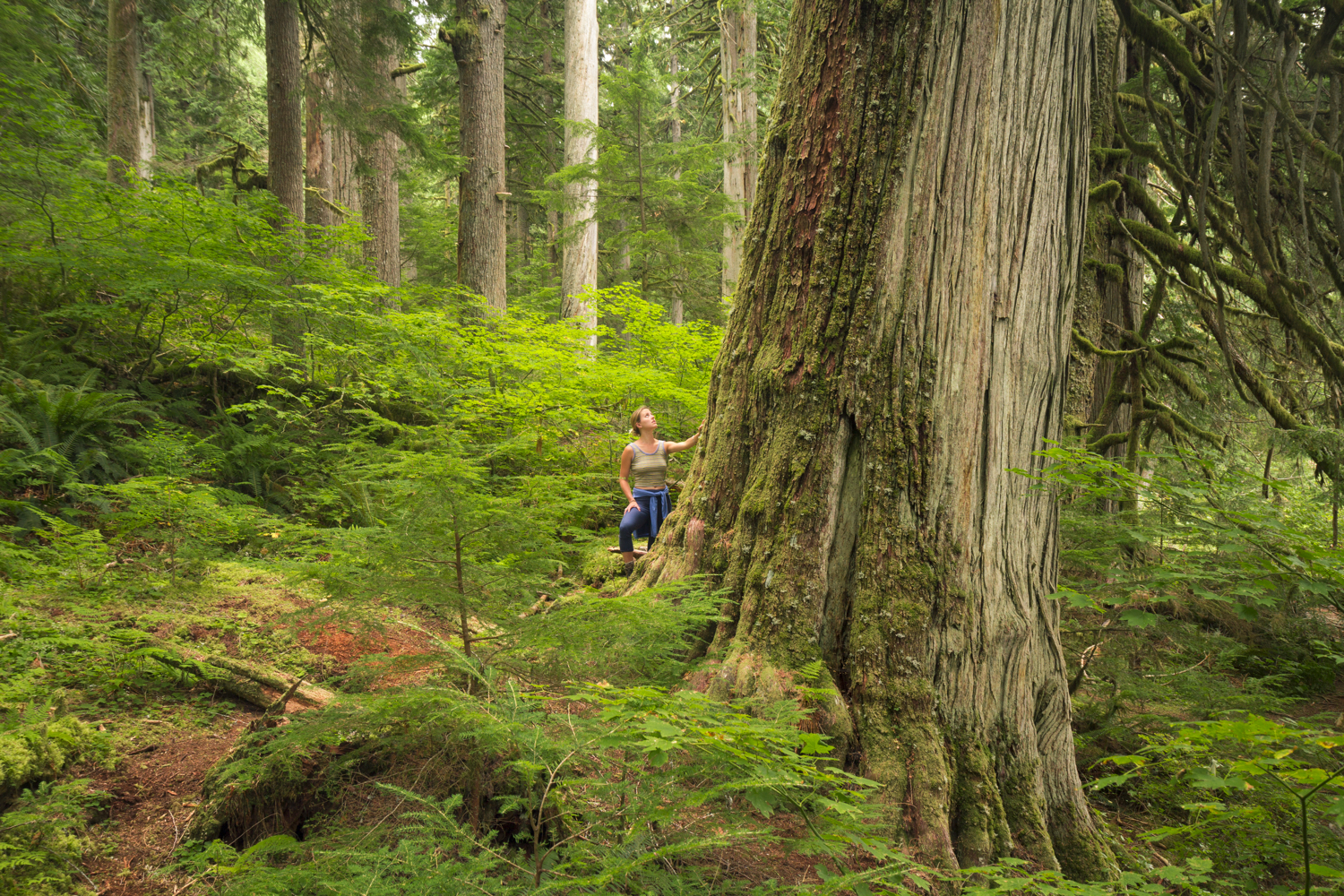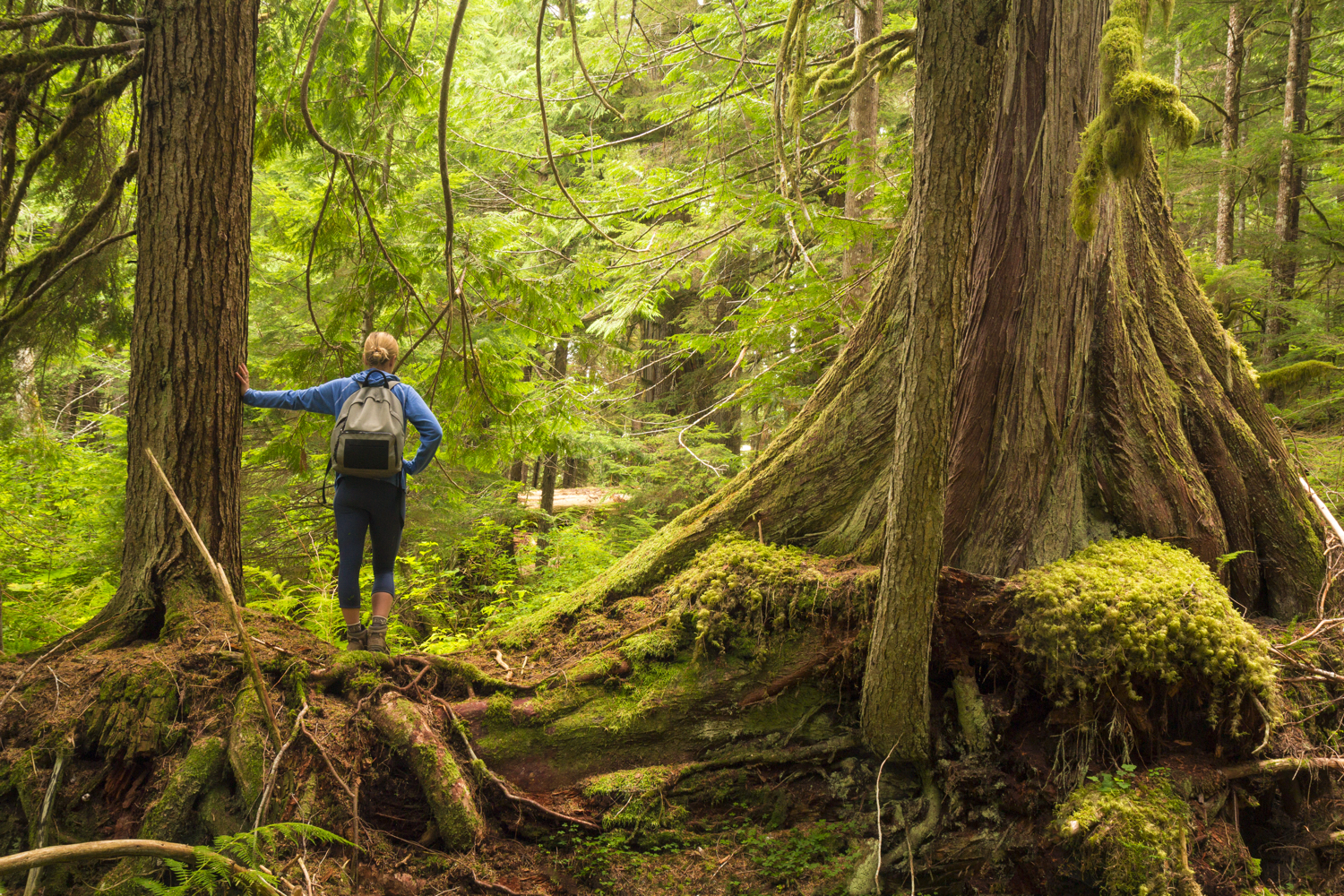Chilliwack Lake Provincial Park
Flanked by beautiful towering mountains that are snow-capped in the winter, Chilliwack Lake is among Lower Mainland’s most stunning natural wonders. The lake itself is worth the visit, but the Chilliwack River, which flows at the lake’s southern terminus, adds extra incentive. The trails here traverse outstanding groves of cedar, fir, and spruces. Indeed, the unique growths and odd shapes of old-growth trees are on full display for hikers willing to explore.
On the east side of the river, the Chilliwack River Trail follows the river closely, moving in and out of the dense forest. It is a rough route where often only the occasional flagging tape dictates the direction. If followed long enough, it passes by the largest known grand fir and crosses the international border with the United States. At that point, hikers enter North Cascades National Park in Washington, and the trail deteriorates even further until it reaches Bear Creek Camp, approximately six miles from Chilliwack Lake.
The Hanging Lake Trail, west of the Chilliwack River, is a much rougher trail. It runs mostly through the Chilliwack River Ecological Reserve, an area set aside "for the preservation and study of natural systems and processes," as its sign proclaims. Accessing the trail requires fording the river—a logistically difficult endeavor. Only the most experienced off-trail hikers can successfully make the climb to Hanging Lake, near the international border at around 4,800 feet in elevation, and through an extreme bushwhack.
Cypress Provincial Park
The ancient forests of Cypress Provincial Park contain record-breaking trees, including western hemlocks, Amabilis fir, and mountain hemlocks, but it's the collection of yellow-cedars (or yellow-cypress) here that elevates this park to legendary status. Perched high above Vancouver in the snowy hillsides, the forest here has not seen a major fire for 1,500–2,000 years and possibly 4,000 years. Though the trees here develop slowly due to the short growing season, some are nonetheless enormous.
Cypress bowl road
Randy Stoltmann’s Hiking Guide to the Big Trees of Southwestern British Columbia highlights two attractions on the drive through Cypress Provincial Park. The first is a short path leading to a small patch of large trees near a ski area service yard. Though the path can be found, it has fallen into disrepair since the book’s publication, and one must bushwhack and navigate up, down, and around blowdown to follow it. Regardless, the big trees that Mr. Stoltmann describes are still there. Some are alive, and some are decomposing, but they grow close to each other and look beautiful together.
The other is a "Roadside Yellow-Cedar" thought to be over 1,200 years old, standing 130 feet tall and 7.5 feet in diameter. The trunk barely tapers as it rises above the much more slender and younger trees around it.
Roadside Yellow-Cedar
Hollyburn mountain/Hollyburn Ancient Forest Loop Trail
For big tree enthusiasts, the trails criss-crossing Hollyburn Mountain’s western face are no doubt a major highlight in Cypress Provincial Park. Hikers traverse a centuries-old forest of massive western hemlock and yellow-cedar. It’s an amazing experience to walk among trees that haven’t experienced a fire disturbance since perhaps some of the earliest major civilizations on Earth.
From the ski lift area, follow the Baden-Powell Trail southeast as it climbs the mountain and marvel at groves of huge yellow-cedars. One of the best sections lies off-trail where the Baden-Powell meets the Old Mount Strachan Trail. Take the Strachan Trail back northwest, following the flagging and tape. Before it turns southwest to meet the Baden-Powell again and close the loop, the trail passes the Hollyburn Giant, one of the girthiest yellow-cedars in British Columbia. Though the tree is dead and collapsing as a snag, its shape and size are still amazing.
Hollyburn Giant
Stanley Park
Vancouver’s signature park, Stanley Park, is a wonderful urban oasis with awesome cliff-side views of the city’s Inner and Outer Harbors, and, of course, the largest remnant of old-growth forest in the metropolitan area. I’ve found that the largest and oldest trees are primarily situated in the southwestern section of the park, west of Highway 99 (Stanley Park Causeway). All three of the photos pictured here were taken while exploring the dozens of informal side trails that branch off the paved trails.
Some of the most ancient cedars and Douglas firs in the park are located south of the east-west Meadow Trail and Lake Trail, and north of Lees Trail. The best section to focus on is around Lovers Walk/Tatlow Walk and explore north and south of there. Some of the cedars right off these Walks are amazing, but it’s always best to push into the forest for a more authentic experience.
Lynn Headwaters Regional Park
The steep mountainsides of the Lynn Valley filter plenty of rain and precipitation down their steep slopes throughout the year, nourishing the giant trees that thrive there. Several trails that cut into the old-growth forest are shared by hikers and mountain bikers alike. Though much of the original woody vegetation has been logged, and sizable stumps remain as monuments to an earlier era, a few huge western red cedars can still be found on the park’s unmaintained west trail.
Most hikers know about the 600-year-old specimen on this "Cedar Trail," but only a small fraction know about the side trail closer to the beginning that leads to an even larger cedar, as well as a big Douglas fir. Though short, this side trail is rough and takes some route-finding skills to follow.
Hollyburn Fir
Hollyburn Ridge
A network of trails weaves around an ancient forest at the foothills of North Vancouver’s mountains in an area known as Hollyburn Ridge. Though the Ridge’s largest cedars were logged in the 1920s, several pockets of old-growth remain, including two of the largest Douglas firs in Lower Mainland, the Hollyburn Fir and the Candelabra Fir.
The Brother’s Creek Loop Trail is perhaps the best trail to use to experience this forest’s majestic cedars (pictures one and two), while the Crossover Trail provides access between the aforementioned giant firs. When wet, this area often collects significant mist, giving it an overwhelmingly otherworldly feel.
Candelabra Fir






















